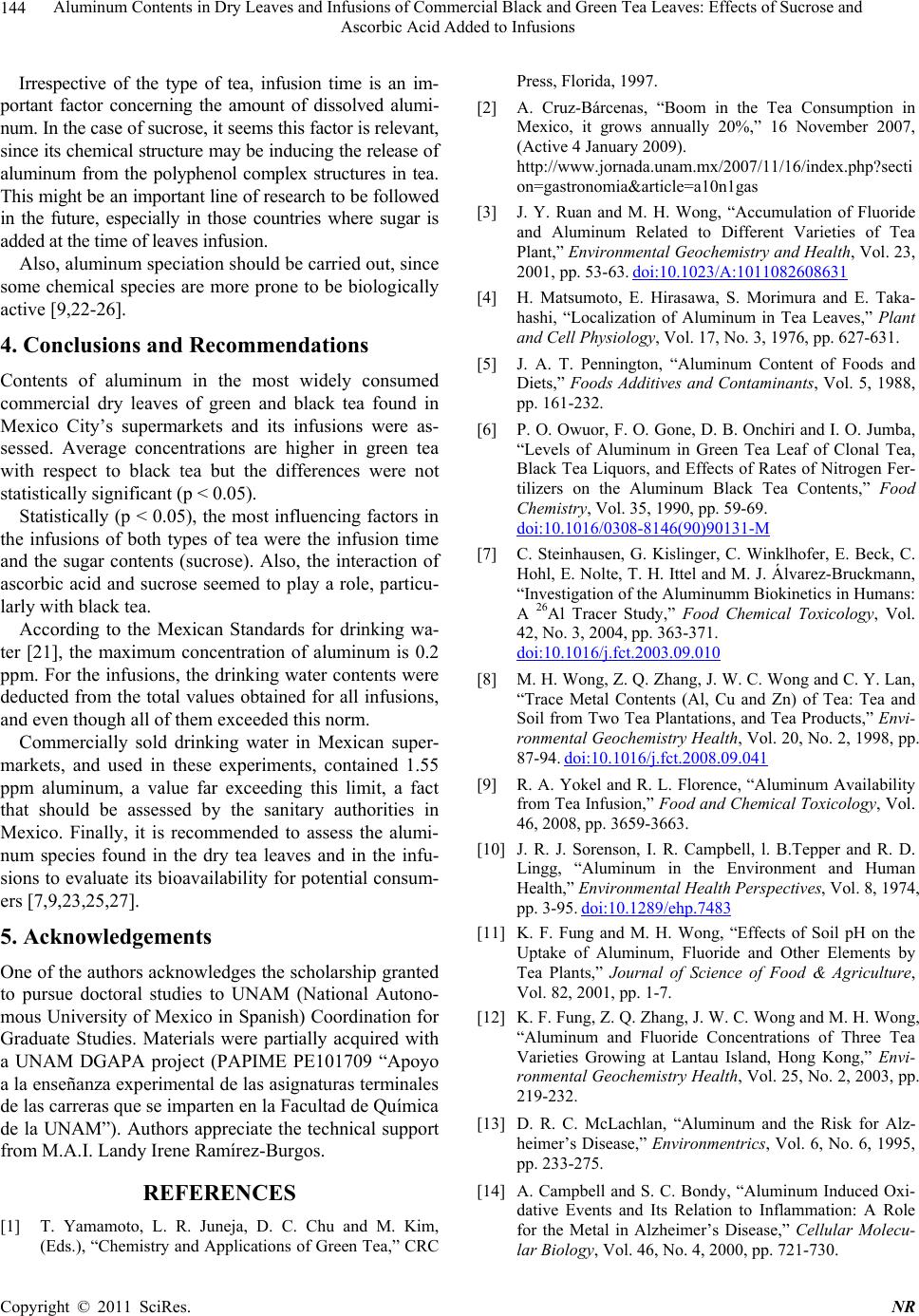
Aluminum Contents in Dry Leaves and Infusions of Commercial Black and Green Tea Leaves: Effects of Sucrose and
144
Ascorbic Acid Added to Infusions
Irrespective of the type of tea, infusion time is an im-
portant factor concerning the amount of dissolved alumi-
num. In the case of sucrose, it seems this factor is relevant,
since its chemical structure may be inducing the release of
aluminum from the polyphenol complex structures in tea.
This might be an important line of research to be followed
in the future, especially in those countries where sugar is
added at the time of leaves infusion.
Also, aluminum speciation should be carried out, since
some chemical species are more prone to be biologically
active [9,22-26].
4. Conclusions and Recommendations
Contents of aluminum in the most widely consumed
commercial dry leaves of green and black tea found in
Mexico City’s supermarkets and its infusions were as-
sessed. Average concentrations are higher in green tea
with respect to black tea but the differences were not
statistically significant (p < 0.05).
Statistically (p < 0.05), the most influencing factors in
the infusions of both types of tea were the infusion time
and the sugar contents (sucrose). Also, the interaction of
ascorbic acid and sucrose seemed to play a role, particu-
larly with black tea.
According to the Mexican Standards for drinking wa-
ter [21], the maximum concentration of aluminum is 0.2
ppm. For the infusions, the drinking water contents were
deducted from the total values obtained for all infusions,
and even though all of them exceeded this norm.
Commercially sold drinking water in Mexican super-
markets, and used in these experiments, contained 1.55
ppm aluminum, a value far exceeding this limit, a fact
that should be assessed by the sanitary authorities in
Mexico. Finally, it is recommended to assess the alumi-
num species found in the dry tea leaves and in the infu-
sions to evaluate its bioavailability for potential consum-
ers [7,9,23,25,27].
5. Acknowledgements
One of the authors acknowledges the scholarship granted
to pursue doctoral studies to UNAM (National Autono-
mous University of Mexico in Spanish) Coordination for
Graduate Studies. Materials were partially acquired with
a UNAM DGAPA project (PAPIME PE101709 “Apoyo
a la enseñanza experimental de las asignaturas terminales
de las carreras que se imparten en la Facultad de Química
de la UNAM”). Authors appreciate the technical support
from M.A.I. Landy Irene Ramírez-Burgos.
REFERENCES
[1] T. Yamamoto, L. R. Juneja, D. C. Chu and M. Kim,
(Eds.), “Chemistry and Applications of Green Tea,” CRC
Press, Florida, 1997.
[2] A. Cruz-Bárcenas, “Boom in the Tea Consumption in
Mexico, it grows annually 20%,” 16 November 2007,
(Active 4 January 2009).
http://www.jornada.unam.mx/2007/11/16/index.php?secti
on=gastronomia&article=a10n1gas
[3] J. Y. Ruan and M. H. Wong, “Accumulation of Fluoride
and Aluminum Related to Different Varieties of Tea
Plant,” Environmental Geochemistry and Health, Vol. 23,
2001, pp. 53-63. doi:10.1023/A:1011082608631
[4] H. Matsumoto, E. Hirasawa, S. Morimura and E. Taka-
hashi, “Localization of Aluminum in Tea Leaves,” Plant
and Cell Physiology, Vol. 17, No. 3, 1976, pp. 627-631.
[5] J. A. T. Pennington, “Aluminum Content of Foods and
Diets,” Foods Additives and Contaminants, Vol. 5, 1988,
pp. 161-232.
[6] P. O. Owuor, F. O. Gone, D. B. Onchiri and I. O. Jumba,
“Levels of Aluminum in Green Tea Leaf of Clonal Tea,
Black Tea Liquors, and Effects of Rates of Nitrogen Fer-
tilizers on the Aluminum Black Tea Contents,” Food
Chemistry, Vol. 35, 1990, pp. 59-69.
doi:10.1016/0308-8146(90)90131-M
[7] C. Steinhausen, G. Kislinger, C. Winklhofer, E. Beck, C.
Hohl, E. Nolte, T. H. Ittel and M. J. Álvarez-Bruckmann,
“Investigation of the Aluminumm Biokinetics in Humans:
A 26Al Tracer Study,” Food Chemical Toxicology, Vol.
42, No. 3, 2004, pp. 363-371.
doi:10.1016/j.fct.2003.09.010
[8] M. H. Wong, Z. Q. Zhang, J. W. C. Wong and C. Y. Lan,
“Trace Metal Contents (Al, Cu and Zn) of Tea: Tea and
Soil from Two Tea Plantations, and Tea Products,” Envi-
ronmental Geochemistry Health, Vol. 20, No. 2, 1998, pp.
87-94. doi:10.1016/j.fct.2008.09.041
[9] R. A. Yokel and R. L. Florence, “Aluminum Availability
from Tea Infusion,” Food and Chemical Toxicology, Vol.
46, 2008, pp. 3659-3663.
[10] J. R. J. Sorenson, I. R. Campbell, l. B.Tepper and R. D.
Lingg, “Aluminum in the Environment and Human
Health,” Environmental Health Perspectives, Vol. 8, 1974,
pp. 3-95. doi:10.1289/ehp.7483
[11] K. F. Fung and M. H. Wong, “Effects of Soil pH on the
Uptake of Aluminum, Fluoride and Other Elements by
Tea Plants,” Journal of Science of Food & Agriculture,
Vol. 82, 2001, pp. 1-7.
[12] K. F. Fung, Z. Q. Zhang, J. W. C. Wong and M. H. Wong,
“Aluminum and Fluoride Concentrations of Three Tea
Varieties Growing at Lantau Island, Hong Kong,” Envi-
ronmental Geochemistry Health, Vol. 25, No. 2, 2003, pp.
219-232.
[13] D. R. C. McLachlan, “Aluminum and the Risk for Alz-
heimer’s Disease,” Environmentrics, Vol. 6, No. 6, 1995,
pp. 233-275.
[14] A. Campbell and S. C. Bondy, “Aluminum Induced Oxi-
dative Events and Its Relation to Inflammation: A Role
for the Metal in Alzheimer’s Disease,” Cellular Molecu-
lar Biology, Vol. 46, No. 4, 2000, pp. 721-730.
Copyright © 2011 SciRes. NR